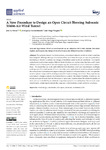A New Procedure to Design an Open Circuit Blowing Subsonic Moist-AirWind Tunnel

Use este enlace para citar
http://hdl.handle.net/2183/35087
A non ser que se indique outra cousa, a licenza do ítem descríbese como Creative Commons Attribution 4.0 International (CC BY)
Coleccións
Metadatos
Mostrar o rexistro completo do ítemTítulo
A New Procedure to Design an Open Circuit Blowing Subsonic Moist-AirWind TunnelData
2023Cita bibliográfica
Orosa, J.A.; García-Bustelo, E.J.; Vergara, D. A New Procedure to Design an Open Circuit Blowing Subsonic Moist-Air Wind Tunnel. Appl. Sci. 2023, 13, 11021. https://doi.org/10.3390/app131911021
Resumo
[Abstract] The present research work shows how a functional subsonic moist-air wind tunnel has been designed. Although this type of wind tunnel has never been developed to date, it is particularly interesting to develop a satisfactory design of feasibility under moist air conditions. Low-speed vertical-axis wind turbines employ different kinds of rotors, such as Savonius, Darrieus, and H-rotor. All these wind turbines present clear advantages, e.g., the horizontal-axis wind turbines are omnidirectional. This means they can work under different wind directions, need lower maintenance, and begin working under low wind speeds of 3 m/s. Recently, a new application of wind concentrators enabled the vertical-axis wind turbines to improve their performance coefficient based on new concepts like moist air phase change, which are being analysed to improve energy conversion. Thus, expectations were raised to design a suitable wind tunnel that accounts for the relative humidity of moist air. An initial prototype showed that the behaviour of open wind tunnels where the relative humidity of moist air was controlled by an adiabatic evaporative process was satisfactory. However, for such wind tunnels, certain improvements like computer control systems would need to be developed.
Palabras chave
Wind energy
Concentrator
Low speed
Moist air
Experiment
CFD
Concentrator
Low speed
Moist air
Experiment
CFD
Versión do editor
Dereitos
Creative Commons Attribution 4.0 International (CC BY)






